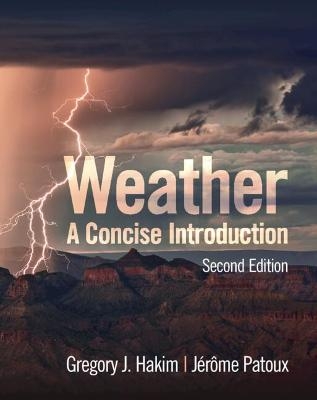
Weather
Cambridge University Press (Verlag)
978-1-108-96559-0 (ISBN)
The second edition of this concise, affordable textbook is ideal for curious undergraduate majors and non-majors taking a first course in meteorology. The first two chapters introduce readers to the main concepts and tools used to analyze weather patterns. Chapters 3-8 provide a foundational understanding of the fundamental processes taking place in the atmosphere, and in Chapters 9-12 these physical concepts are applied to specific weather phenomena. Weather concepts are then used in Chapters 13-15 to explain weather forecasting, air pollution, and the impact of climate change on weather. Key concepts are illustrated through a running case study of a single mid-latitude cyclone, providing students with an opportunity to progressively develop their understanding of weather phenomena with a familiar example approached from multiple perspectives. This edition includes expanded and updated coverage of precipitation types and formation, satellite and radar technology, tornadoes, and more. It also features thought-provoking end-of-chapter review questions, new visual analysis exercises, an expanded test bank and nearly 100 new figures.
Professor Greg Hakim is a leading scientist in the areas of weather analysis, predictability and dynamics. His research interests include weather and climate prediction, hurricanes, past climates, and polar circulation patterns. He is author of over eighty scientific papers and a leading textbook on dynamic meteorology. He has served on the advisory panel for the Directorate of Geosciences at the National Science Foundation, as Chair of the advisory panel for the Mesoscale and Microscale Meteorology Laboratory at the National Center for Atmospheric Research (NCAR), as a member of the NCAR Advisory Panel, as a member of the NCAR Strategic Planning Council, and as Chair of the University Corporation for Atmospheric Research's President's Advisory Committee on University Relations. He has undergraduate degrees in Math and Atmospheric Sciences, and a Ph.D. in Atmospheric Science from the University at Albany, State University of NY. After a postdoctoral fellowship in the Advanced Study Program at NCAR, Greg joined the Department of Atmospheric Sciences at the University of Washington in 1999 where he is a Professor, won the department teaching award, and served as Department Chair from 2012-2017. Jérôme Patoux, Ph.D., is a former faculty member from the Department of Atmospheric Sciences at the University of Washington, Seattle. He earned a Master's degree in environmental engineering from the University of Texas at Austin and a doctorate in atmospheric science from the University of Washington, Seattle. He has been funded by the National Science Foundation (NSF), the National Aeronautics and Space Administration (NASA), the Office of Naval Research (ONR), and the National Oceanic and Atmospheric Administration (NOAA). He has taught undergraduate introductory meteorology for many years, and has been funded by NSF to develop weather and climate curriculum. He currently teaches in the Education Division of the Museum of Science and Industry in Chicago.
Contents; Preface; Introduction; 1. Weather variables; 2. Spatial representations of weather data; 3. Our atmosphere: origin, composition, and structure; 4. Heat and energy transfer; 5. Water; 6. Cloud formation; 7. Precipitation; 8. Wind; 9. Global wind systems; 10. Air masses, fronts, and midlatitude cyclones; 11. Thunderstorms and tornadoes; 12. Tropical cyclones; 13. Weather forecasting; 14. Air pollution; 15. Climate change and weather; Glossary; References; Credits; Index.
| Erscheinungsdatum | 29.10.2021 |
|---|---|
| Zusatzinfo | Worked examples or Exercises |
| Verlagsort | Cambridge |
| Sprache | englisch |
| Maße | 220 x 276 mm |
| Gewicht | 920 g |
| Themenwelt | Sachbuch/Ratgeber ► Natur / Technik ► Natur / Ökologie |
| Naturwissenschaften ► Geowissenschaften ► Meteorologie / Klimatologie | |
| Naturwissenschaften ► Physik / Astronomie ► Angewandte Physik | |
| ISBN-10 | 1-108-96559-8 / 1108965598 |
| ISBN-13 | 978-1-108-96559-0 / 9781108965590 |
| Zustand | Neuware |
| Haben Sie eine Frage zum Produkt? |
aus dem Bereich


